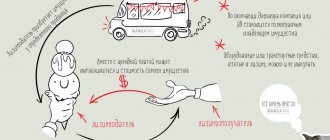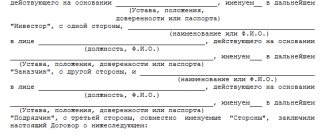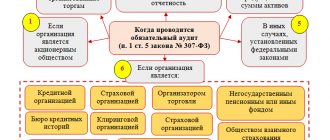Main participants
As a rule, the following persons are involved in a leasing agreement:
— lessee (legal entity or individual);
— lessor (leasing companies, banks, as well as individuals), who acquires the property required by the client and leases it to the latter;
- supplier or seller of property who supplies the lessor with the required property;
- an insurer (insurance company), which (if necessary) insures various risks associated with the leased property.
The last participant is optional. As a rule, the initiator of insurance is the lessor. He can either suggest his own insurer or leave this choice to the client. For example, insurance is common when leasing vehicles.
financial leasing
Leasing (or finance lease)
allows you to purchase the latest equipment, expand production, introduce advanced technologies, increase the fixed assets of the enterprise without diverting large sums from turnover. Essentially, this is a long-term lease. And depending on whether the agreement provides for the possibility of complete redemption by the recipient of the leased property, leasing is divided into operational and financial.
Operating leasing
implies that the company transfers its property for temporary use. Upon expiration of the agreed period and subject to full payment of the rent, the item is returned to the owner. A distinctive feature of this type is that the lease term will be less than the depreciation period of the leased property. That is, a company can rent out property repeatedly throughout its depreciation period. Another feature is that the item is not placed on the recipient’s balance sheet, which means that all risks and expenses fall on the bank (as the owner). Another difference between operational leasing (which follows from its name) is the short period for which the property is leased. If there is no need to acquire ownership of this property, but it is only needed to perform specific work, then this type is ideal.
If the object is to be used for a long time with its subsequent purchase from the bank, then we are talking about financial leasing. Financial leasing provides for the transfer of property and full reimbursement of its value during the term of the contract. After payments are made, the property is redeemed by the recipient at the residual value. That is, the company fully reimburses the initial cost of the company’s property. A distinctive feature is that the period for which property is transferred for temporary use is close in duration to the depreciation period of the property. The property is listed on the bank's balance sheet until the rental property is fully purchased. When this happens, the property will become the property of the recipient.
Figure 1. “Comparative characteristics of operational and financial leasing”
Data: Networks and Telecommunications magazine When concluding a transaction, the agreement is signed by three parties: the property supplier, the lessor and the recipient. A fourth party, an insurance company, may also be involved. An agreement is concluded between the bank and the recipient, and a purchase and sale agreement is concluded between the bank and the supplier. After the contract expires, the company may (but is not obligated) to purchase the property at its residual value. In some cases, property may be transferred to the recipient free of charge after payments are completed, if this is provided for in the contract.
Figure 3. “Scheme”
Scheme
Participants in a financial leasing transaction
- The recipient
is an enterprise that orders the purchase of an item from the company, which after the end of the contract can be purchased at its residual value. - Bank
- a bank or company that, at the request of a client, acquires (at the expense of its own or borrowed funds) the subject of a financial lease for its subsequent rental with the option of repurchase at the end of the term. - The seller
is a company that sells to the leasing company property that is necessary for the recipient’s production activities.
Other participants may also be involved. For example, if the purchase of an item is carried out not from the company’s own funds, but from borrowed funds, then a creditor (bank, credit organization) appears in the transaction. An insurance company may also be hired to insure property and other risks.
Who benefits from leasing?
Leasing is most beneficial for legal entities and here’s why:
— allows you to rent any property required for running a business, for a long period of time and at reasonable interest rates;
— payments are made according to a scheme convenient for the legal entity (can be included in expense transactions), allowing to minimize the tax burden;
- at the end of the contract, the property becomes property.
It is especially beneficial for small and medium-sized businesses, for which obtaining a “classic” loan from a bank is associated with a number of difficulties.
An important nuance: often the lessor is ready to receive the down payment only after the leased property begins to generate profit.
In other words, a leasing agreement allows not only to reduce the costs of a legal entity, but also to quickly acquire the property required for running a business.
What is more profitable - a loan or leasing?
In the most general case, leasing is more profitable than a loan when purchasing vehicles, special equipment, commercial vehicles and other equipment. In some cases, they also indicate savings on property tax, but this savings, in my opinion, is very conditional, since the company usually includes the amount of property tax in the amount of payments. In addition, the leased object itself can be immediately registered with the borrower-recipient.
For clarity, let’s consider purchasing equipment on lease. The cost of the equipment is 14 million rubles, the term is 3 years, the recipient's advance payment is 30% of the cost of the equipment, the interest rate on the loan is 19% per annum, the loan term is 3 years. The cost will depend on whose balance this equipment will be accounted for, the recipient or the bank.
| Balance holder: recipient | Balance holder: bank | Loan payments | |
| Monthly payment | 426 071, 92 | 438 997, 70 | 359 229 |
| Total amount of payments including VAT, rubles | 19 540 510, 73 | 20 005 096, 81 | 17 132 244 |
| Increase in price per year, interest per annum | 13,19% | 14,29% | 19% |
| Amount of VAT to be reimbursed, rubles | 2 980 755, 87 | 3 051 624, 94 | 2 135 593 |
| Savings on income tax, rubles | 4 689 722, 57 | 4 801 223, 23 | 626 448 |
| Purchase costs including savings, rubles | 11 870 032, 29 | 12 152 248, 63 | 14 370 203 |
From this table it can be seen that the amount of monthly payments for a loan will be less, but the total amount, taking into account all the savings on income tax and VAT when leasing, will be significantly less.
How it happens
Typically, a leasing transaction follows the following standard scheme:
1. A person interested in leasing property contacts the lessor. The parties discuss the nuances, the lessee fills out the appropriate application, if approved, the second stage begins: the stage of signing contracts.
2. In addition to the agreement between the lessee and the lessor, an agreement is concluded with the supplier, and, if necessary, with the insurance company;
3. The required property is purchased by the lessor and transferred to the client;
4. If the client fulfills all the terms of the contract, upon its expiration the rented property becomes the property of the client (unless otherwise specified in the contract).
Leasing: functions
Currently, leasing has become widespread. These operations are carried out both at the level of individuals and organizations, and at the state level. The main aspects of such business relationships are:
- Financial – opens up the opportunity for the customer (lessee) to use the necessary property for their own business or production purposes without the need for direct acquisition and a one-time investment of a large amount of funds.
- Production aspect – provides the leasing customer with access to the latest equipment and machinery without having to pay for its expensive purchase. In the case of lessees who are associated with production or seasonal industries, they have the opportunity to use the necessary equipment only when there is a real need for it.
- Sales aspect – steel engine leasing operations for manufacturers. They expanded their sales market to those consumers who previously could not afford to purchase their products or services.
From the above points we see that leasing is an integral part of the economy, and its functions are a favorable factor for all participants in the operation. Moreover, the parties entering into an agreement between themselves automatically receive the right to a number of concessions from the tax system, which makes it possible to reduce their own costs, quite noticeably.
Advantages and disadvantages of leasing
The advantages of leasing include the following:
— duration (up to 10 years), allowing you to comfortably pay the other party to the contract;
- lower interest rate;
— you can purchase used property;
— flexible payment schedule: it is possible to extend or write off the value of the property, taking into account its physical depreciation);
— the right to a VAT refund on leasing payments (for legal entities);
— faster review time;
— a more loyal attitude towards the client (the requirements are much softer than in a bank).
The last point is especially beneficial for small and medium-sized businesses.
But the most important advantage of leasing for the lessee is the real opportunity, even with limited finances, to partially or completely replace the outdated property of the enterprise (equipment or vehicle fleet). This means not only reaching a new technological and competitive level with all the ensuing consequences in the form of increased production and profits, but also planning your business for years to come.
The list of shortcomings is not so long, but, unfortunately, it also exists:
— the client is not the owner of the property and does not have the right to dispose of it at his own discretion;
— payments are subject to VAT.
- the lessor is the owner of the property until the end of the lease term, with all the ensuing consequences. Thus, the bankruptcy of the lessor threatens the client with the loss of the leased property.
Subject of leasing
The object of leasing can be property complexes, equipment, vehicles and any other non-usable things that can be used to conduct business activities. In this case, the subject of leasing cannot be land plots and environmental areas.
Equipment leasing is one of the profitable ways that allows a company to increase production without significant costs, build new workshops and update technology through the purchase of technical innovations. Among the main advantages of leasing equipment are the following:
- the company gets the opportunity to develop even with only part of the money for equipment;
- payments are distributed in advance and made according to the agreed schedule;
- the lessee becomes the owner of the equipment immediately after signing the contract and can use it in production;
- monthly payments are covered by the profit received from the operation of the equipment.
Car leasing
Not only a legal entity, but also an individual can purchase a car on lease. This is a new type of financial transactions for the domestic market, but it is rapidly progressing due to the unique leasing structure. Any citizen of the Russian Federation has the right to buy a vehicle as if on lease, but at the end of the contract he will become its owner.
The motorist will receive the right to use the vehicle immediately after making the advance and first payment. Today, such services are offered not only by leasing companies, but also by banking institutions, as well as car dealerships.
The main advantages of car leasing:
- You can buy not only a passenger car, but also a truck, as well as specialized equipment.
- The condition of the car doesn't matter. You can also buy a used version.
- To complete a transaction, you need to provide a minimum package of documents.
- The level of requirements is much lower than when applying for a loan.
- The lease period is no more than 5 years, and after the end of the contract, the client can become the owner of the car by paying the remaining amount.
Real estate leasing
Real estate leasing is a cross between rent and mortgage. The essence of the deal is that the leasing company buys the property chosen by the client and then rents it out. The client must pay every month for the use of the apartment based on the leasing agreement.
A mortgage agreement is cheaper than a leasing agreement. The only advantage of real estate leasing is the reliability of the transaction for all participants. With a mortgage, the bank always remains at risk that the client will not be able to pay, as a result of which the financial institution will be forced to take additional measures and incur costs to defend its interests.
As for the leasing company, it is the owner of the living space, so it does not lose anything, even if the client turns out to be insolvent. That is why the lessor is more loyal to clients with not the best credit history.
Advantages of leasing for the lessor
The benefits of leasing over a conventional loan are also obvious to the other party to the transaction - the lessor. It is not without reason that, in addition to classic leasing companies, more and more banks are involved in leasing transactions. They even create special departments for such transactions. What are the benefits:
— minimization of risks, since the leased property itself is the collateral; in the event of bankruptcy of the lessee, the lessor has the primary right to receive compensation;
- opportunity to save on taxes.
Basic requirements of lessors
To approve a leasing transaction, before concluding a contract, company employees conduct a detailed analysis of the client. The recipient must provide a certain list of documents, the list of which may differ depending on the characteristics of the property and the requirements of the lessor. The requested documents can be divided into two groups: legal and financial.
Legal documents include the charter and constituent documents of the company, a certificate of registration, registration with the tax service, decisions on the appointment of managers and a protocol on the conclusion of a leasing transaction.
In addition, the lessor has the right to request extracts from the Unified State Register of Legal Entities, copies of passports of managers and founders, licenses for a certain type of activity, etc. Legal documents are submitted so that the lessor can obtain basic information about the recipient and his legal status, as well as the availability restrictions on concluding transactions.
Financial documents include accounting reports, information about current accounts and turnover for a certain period of time. Additional documents may include information about accounts receivable, audit reports and information about main counterparties.
The main purpose of studying the recipient's financial documents is to assess the solvency of the company.
In order to purchase property on lease, you should also submit an application in a special form, which will reflect information about the property, suppliers, as well as basic data about the recipient’s activities.
Each lessor has its own specifics: in order to analyze a potential client, company representatives may request a variety of documents and transcripts.
What is leasing
The definition of a contract is given by Art. 665 Civil Code.
Finance lease scheme for business
- The lessee instructs the lessor which car to buy.
- The lessor buys the vehicle.
- Then, for a fee, he provides the vehicle for use to the tenant.
The Civil Code gives the parties the right to supplement the agreement with any conditions.
So, leasing is the paid use of transport for a long period of time. After the end of the contract, the lessee buys the car.
Important! The parties may establish that the lessor himself chooses the seller from whom to purchase the vehicle.
A leasing organization is chosen as an intermediary for the buyer-seller transaction.
Recommendations for choosing a leasing company
When choosing a company, it is important to pay attention to several things. First of all, this is the initial cost of the product - the less, the better. Operating costs are assessed before renting the property. In some cases, they turn out to be large, so it is logical to choose a leasing company with a range of services. An important parameter is the liquidation value, thanks to which it is possible to return part of the funds spent at the end of the contract period. It is calculated empirically after studying the sales market of the selected category of used goods.
Various leasing organizations include additional services in the agreement, paid by the tenant. Their quantity and cost vary. You should agree to additional services if the tenant is not able to ensure normal operation of the leased object on his own. You should also pay attention to the terms of the contract, which are marked with asterisks and have footnotes. You should always remember the advantages and disadvantages of leasing; sometimes getting a loan is easier and more profitable. In particular, this applies to cases where the bank’s offer assumes the absence of a down payment or income certificate.
In simple words.
Question: “What is leasing in simple words?”
Leasing is when you (the lessee company) contact the leasing company (the lessor). You agree that you will rent equipment or other property from them on such and such terms. The leasing company buys the equipment you require from a third company (seller) and leases it to you. This operation will allow your company to obtain tax advantages and use the necessary equipment and property without purchasing it.
What are the disadvantages of a leasing arrangement?
The transaction has risk. The danger occurs when the financial situation of the organization worsens and the ability to make payments is lost. Then the property is confiscated, and no one will reimburse the costs associated with the execution of the transaction.
The tenant is also responsible for the safety of the property. If the car is damaged, the responsibility for compensation falls on the shoulders of the lessee.
The parties have the right to supplement the contract with other conditions for the implementation of the agreement.
Here are four reasons why car leasing isn't always profitable.
Despite the fact that car leasing for individuals in our country is not as widespread as car loans, the growth of such leasing agreements for the purchase of vehicles is gradually growing. We, dear readers, have previously talked about the profitable new leasing programs that have appeared on the Russian market. But, to our regret, this leasing does not always have an advantage over car loans.
In recent years, many car dealers have often begun to offer us to purchase a car not with a bank loan, but through a leasing program for individuals. Under the terms of this lease, anyone can buy a new car for a minimal down payment and low monthly payments under the contract.
At first glance, it may seem that such leasing actually has an advantage over car loans. But not all friends are so simple. In fact, in fact, such leasing is not exactly a win-win way to buy a car. Thus, before you run to the ATM and withdraw cash for the initial payment of 10 - 20% of the car payment, first read our selection of material that will tell you that purchasing a car on lease in our time is not the best solution, which is ideal for our motorists.











